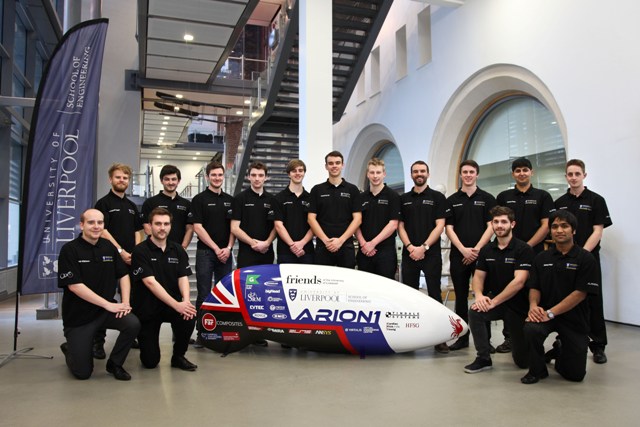Oct 6 2015
The ARION1 Land Speed bicycle, designed and built by The University of Liverpool Velocipede (ULV) Team, has recently competed in the IHPVA “World Human Power Speed Challenge”, which took place from the 14-19 September 2015. Now in its 16th year, this annual speed trial event attracts engineering teams from all over the world to test their designs and their rider’s endurance on the famous five mile highway road at Battle Mountain, Nevada in the USA.
 The ULV 2015 ARION1 Team
The ULV 2015 ARION1 Team
The ULV Team is made up of sixteen undergraduate engineering students, all currently studying for their Masters of Mechanical Engineering (MEng) at the university. The team, which is the first UK university student team to enter the IHPVA event, designed and built the ARION1 two-wheeled velocipede to compete in the main human powered speed challenge “200 metre flying start single rider” category.
The design, engineering and materials selected for ARION1 focused on maximising the aerodynamic performance and minimising the overall weight of the vehicle. Structurally, it needs to handle the high force through the pedals driving the front wheel, support a single rider in a recumbent position and be stable in a straight line at speeds of over 80 mph. Its overall dimensions are approximately 2.8 metres long by 0.85 metres high and 0.5 metre wide. The rider or ‘pilot’ of the ARION1 velocipede sits almost flat with legs forward, completely enclosed inside a two part carbon fibre composite body shell; the top half is removable to enable rider access.
The ULV team selected high performance lightweight composite materials and technologies, including Scott Bader’s carbon fibre compatible Crestapol® 1250LV acrylic laminating resin for the outer shell and the carbon fibre composite (CFRP) chassis frame, and Crestabond® M1-20 primer-less structural adhesive to bond a variety of CFRP and metal parts used internally. Carbon fibre reinforcements, foam core materials and related design and processing technical support were provided by key sponsors of the student project including: Far-UK, Evonik, the UK National Composites Centre (NCC), as well as Scott Bader.
The use of carbon fibre with Crestapol high performance resin inside and out of the ARION1 was extensive to achieve the strength to weight ratio needed for this type of speed challenge vehicle. The aerodynamic, rigid, thin walled, outer body shell is a sandwich laminate construction, moulded using carbon fibre fabric, Crestapol 1250LV infusion resin and cut-to-size sections of ROHACELL® IG rigid closed-cell PMI foam core. The entire internal frame and where possible other components, such as the seat, the front end section and push rods, were also CFRP fabricated parts.
For the critical h-shaped high load bearing frame section that fits around the front wheel supporting the wheel strut, drive chain system and pedals, Far-UK recommended an infused part design using its AxontexTM carbon fibre (CF) braid and foam core system with Crestapol 1250 LV resin. This very lightweight, high modulus, infused sandwich laminate specification was finally chosen by the ULV Team in preference to an epoxy prepreg based option that had also been tested; the Axontex CF braid system provided the flexibility needed to wrap around the curved sections and to accurately conform around machined sections of ROHACELL® IG foam core. Dry lay-up and vacuum infusion at room temperature of the h-section was completed in just a few hours. The use of Crestapol 1250 LV enabled low temperature, rapid cure infusion of the part without any mould expansion. This was a critical factor for the team as the mould was also used as a jig to machine holes in the frame components, so maintaining mould dimensional accuracy was critical. The Crestapol infusion resin was specified as it is fully compatible with the CF braid and was simple to process at ambient temperature to provide the combination of very high strength, stiffness and toughness needed for the bike frame, with no requirement for any post curing.
To minimise weight, Crestabond M1-20 was used extensively throughout the interior of ARION1 to structurally bond CFRP, metal and wood parts, as well as a number of Big Head metal fasteners and fixings of the team’s own design. This included CF-CF bonding of the front end section and the lay shaft mounts into the outer body shell, as well as bonding the anodised aluminium head tube and crankset mounts to the carbon fibre front end member.
The 2015 attempt by the UVL Team made UK record breaking history, with Ken Buckley setting a new human powered British land speed UK record of 75.03 mph piloting ARION1. However, the UVL Team were unable to match the Canadian Team AeroVelo, whose co-designer and rider, Todd Reichert, set a new IHPVA world record of a staggering 85.71 mph. Work on ARION2 is already underway by third year engineering students, for a ULV Team to compete again in 2016.